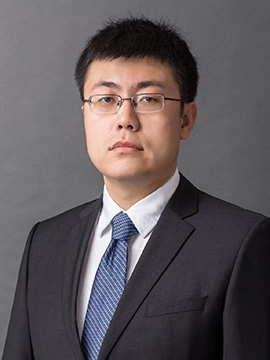研究方向一:功能金属基复合薄膜材料制备及界面调控
(1) M. Yang, Y. Liu, T. Fan, D. Zhang, “Metal-graphene interfaces in epitaxial and bulk systems: A review” Progress in Materials Science, 110 (2020) 100652.
(2) Y. Liu, K.M. Yang, J. Hay, E.G. Fu, X. Zhang, “The effect of coherent interface on strain rate sensitivity of highly textured Cu/Ni and Cu/V multilayers” Scripta Materialia, 162 (2019) 33-37.
(3) H. Zhang, J. Zhang, Y. Liu, F. Zhang, T.X. Fan, D. Zhang, “Unveiling the interfacial configuration in diamond/Cu composites by using statistical analysis of metallized diamond surface” Scripta Materialia, 152 (2018), 84-88.
(4) M. Yang, Y. Liu, H. Zhu, F. Zhang, T. Fan, D. Zhang, “Influences of Interfaces on Dynamic Recrystallization and Texture Evolution During Hot Rolling of Graphene Nanoribbon/Cu Composite” Metallurgical and Materials Transactions A: Physical Metallurgy and Materials Science, 49 (2018) 6401-6415.
(5) D. Bufford, Y.M. Wang, Y. Liu, L. Lu “Synthesis and microstructure of nanotwinned materials” MRS bulletin, 41 (April 2016) 286-291 (invited review)
(6) Y. Liu, J. Hay, H. Wang, X. Zhang, “A new method for reliable determination of strain-rate sensitivity of low-dimensional metallic materials (Cu and Ni) by using nanoindentation” Scripta Materialia, 77 (2014) 5-8
(7) Y. Liu, J. Jian, Y. Chen, H. Wang, X. Zhang, “Plasticity and ultra-low stress induced twin boundary migration in nanotwinned Cu by in situ nanoindentation studies” Applied Physics Letters, 104 (2014), 231910
(8) Y. Liu, Y. Chen, K.Y. Yu, H. Wang, J. Chen, X. Zhang “Stacking fault and partial dislocation dominated strengthening mechanisms in highly textured Cu/Co multilayers” International Journal of Plasticity 49 (2013) 152-163
(9) Y. Liu, D. Bufford, S. Rios, H. Wang, J. Chen, J. Y. Zhang, and X. Zhang, “A formation mechanism for ultra-thin nanotwins in highly textured Cu/Ni multilayers”, Journal of Applied Physics, 111 (2012) 073526
(10)Y. Liu, D. Bufford, H. Wang, C. Sun, X. Zhang, “Mechanical properties of highly textured Cu/Ni multilayers”, Acta Materialia, 59 (2011) 1924-1933
研究方向二:复杂极端服役条件下材料性能及智能预测
(1) J.S. Chen, Y. Liu, R.J. McCabe, J. Wang, C.N. Tomé, “Quantifying elastic strain near coherent twin interface in magnesium with nanometric resolution” Materials Characterization 160 (2020), 110082
(2) Y. Liu, P.Z. Tang, M.Y. Gong, R.J. McCabe, J. Wang, and C.N. Tomé. “Three-dimensional character of the deformation twin in magnesium” Nature Communications, (2019) 10:3308
(3) J.S. Chen, Y. Zhai, Y. Liu, T.X. Fan, “A new method to reliably determine elastic strain of various crystal structures from atomic-resolution images” Scientific Report, (2019) 9: 16399
(4) M. Gong, S. Xu, Y. Jiang, Y. Liu, J. Wang, “Structural Characteristics of {1 0 -1 2} Non-cozone Twin-Twin Interactions in Magnesium” Acta Materialia, 159 (2018) 64-76.
(5) Y. Liu, N. Li, M. Arul Kumar. S. Pathak, J. Wang, R.J. McCabe, N.A. Mara, C.N. Tomé. “Experimental quantifying critical stresses associated with basal slip and twinning in magnesium using micro-pillars” Acta Materialia, 135 (2017) 411-421
(6) Y. Liu, N. Li, S. Shao, J. Wang, R.J. McCabe, Y. Jiang, C.N. Tomé, “Characterizing the boundary lateral to the shear direction of deformation twins in magnesium”, Nature Communications 7 (2016) 11577
(7) Y. Liu, I. Karaman, H. Wang, X. Zhang, “Two types of martensitic phase transformations in magnetic shape memory alloys by in-situ nanoindentation studies“ Advanced Materials, 26 (2014), 3893-3898
(8) D. Bufford, Y. Liu, J. Wang, H. Wang, and X. Zhang, ”In situ nanoindentation study on plasticity and work hardening in aluminum with incoherent twin boundaries“ Nature Communications, 5, (2014) 4864
(9) Y. Chen, K.Y. Yu, Y. Liu, S. Shao, H. Wang, M.A. Kirk, J. Wang, X. Zhang “Damage-tolerant nanotwinned metals with nanovoids under radiation environments” Nature Communications, 6 (2015) 7036
Y. Liu, J. Jian, J. H. Lee, C. Wang, Q.P. Cao, C. Gutierrez, H. Wang, J. Z. Jiang, X. Zhang, ”Repetitive ultra-low stress induced nanocrystallization in amorphous Cu-Zr-Al alloy evidenced by in situ nanoindentation“ Materials Research Letters, 2 (2014) 209-216
